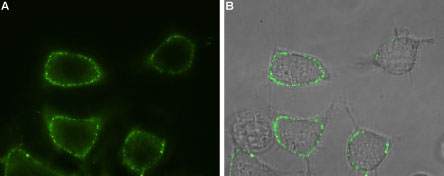Overview
- Peptide (C)KFLPLKRQAGQPS, corresponding to amino acid residues 200-212 of mouse Orai1 (Accession Q8BWG9). 2nd extracellular loop.

- Eisner, D.A. et al. (2005) Exp. Physiol. 90, 3.
- Chakrabarti, R. and Chakrabarti, R. (2006) J. Cell. Biochem. 99, 1503.
- Feske, S. et al. (2006) Nature 441, 179.
- Pickett, J. (2006) Nature Reviews Mol. Cell Biol. 7, 794.
- Luik, R.M. et al. (2006) J. Cell. Biol. 174, 815.
- Wu, M.M. et al. (2006) J. Cell. Biol. 174, 803.
- Ong, H.L. et al. (2007) J. Biol. Chem. 282, 9105.
- Luik, R.M and Lewis, R.S. (2007) Trends Mol. Med. 13, 103.
- DeHaven, W.I. et al. (2007) J. Biol. Chem. 282, 17548.
Cytosolic calcium (Ca2+) has long been known to act as a key second messenger in many intracellular pathways including synaptic transmission, muscle contraction, hormonal secretion, cell growth and proliferation1,2. Intracellular Ca2+ levels are controlled by either the influx of Ca2+ through the calcium-release-activated Ca2+ channels (CRAC), or from intracellular stores which gained much attention.
Recently, several key players of the store operated complex have been identified3. Orai1 (also known as CRACM1) acts as the store operated Ca2+ channel (SOC) and STIM1, which acts as the endoplasmic reticulum Ca2+ sensor3,4. The formation of functional channels requires the presence of both Orai1 and STIM1 proteins working as a complex and involves the co-clustering of Orai1 on the plasma membrane with STIM1 on the endoplasmic reticulum4-6. TRPC1, a member of the transient receptor potential family was also suggested to act as a player in the SOC complex7. In T-cells, Ca2+ entry following activation by antigen-receptor engagement occurs solely through CRAC channels where Orai1 constitutes the pore forming subunit3,8.
Orai1 is a plasma membrane protein with four potential transmembrane domains and intracellular N- and C-terminus. In addition, two mammalian homologs to Orai1 have been identified; Orai2 and Orai33,9. All three, Orai1 Orai2 and Orai3, are capable of forming store operated channels with different magnitudes9.
Application key:
Species reactivity key:
Anti-Orai1 (extracellular) Antibody (#ACC-062) is a highly specific antibody directed against an extracellular epitope of the mouse protein. The antibody can be used in western blot, immunohistochemistry, live cell imaging, and indirect flow cytometry applications. It has been designed to recognize the Orai1 channel from mouse and rat samples.
Anti-Orai1 (extracellular)-ATTO Fluor-488 Antibody (#ACC-062-AG) is directly labeled with an ATTO-488 fluorescent dye. ATTO dyes are characterized by strong absorption (high extinction coefficient), high fluorescence quantum yield, and high photo-stability. The ATTO-488 label is analogous to the well known dye fluorescein isothiocyanate (FITC) and can be used with filters typically used to detect FITC. Anti-Orai1 (extracellular)-ATTO Fluor-488 Antibody has been tested in live cell imaging applications and is especially suited for experiments requiring simultaneous labeling of different markers.
Applications
Citations
- Mouse sample:
La Russa D. et al. (2020) Neuroscience. 441, 8.

